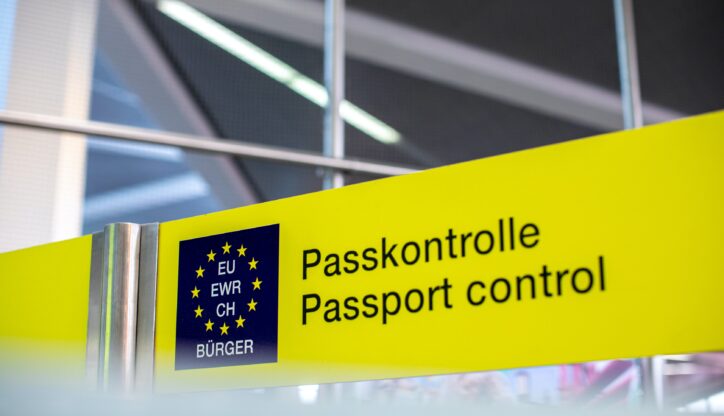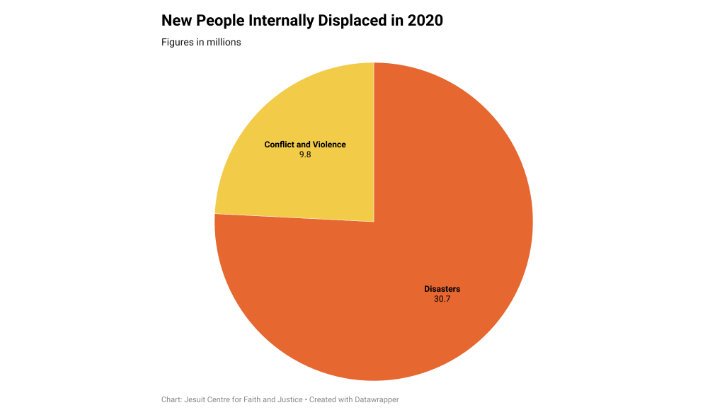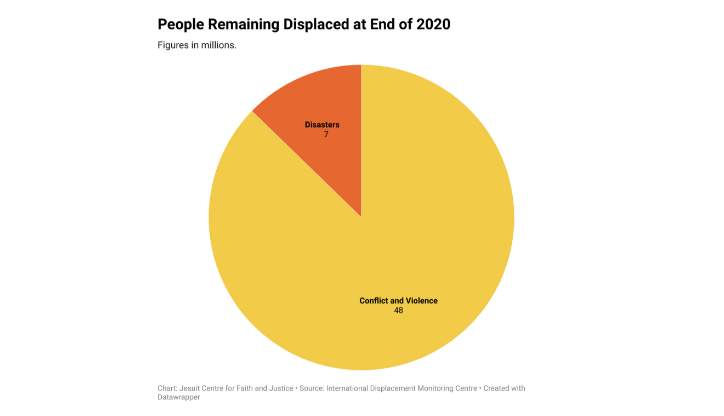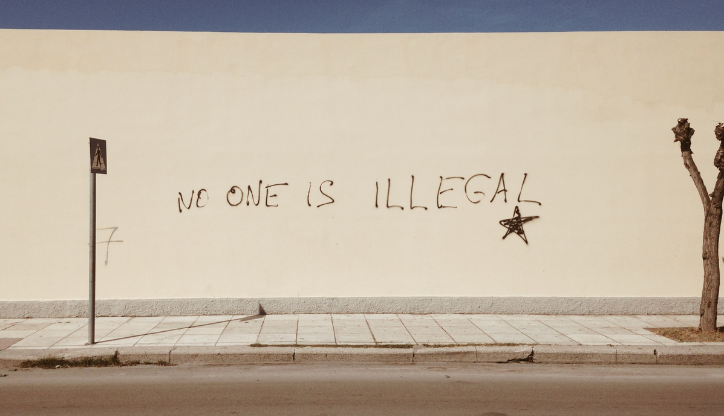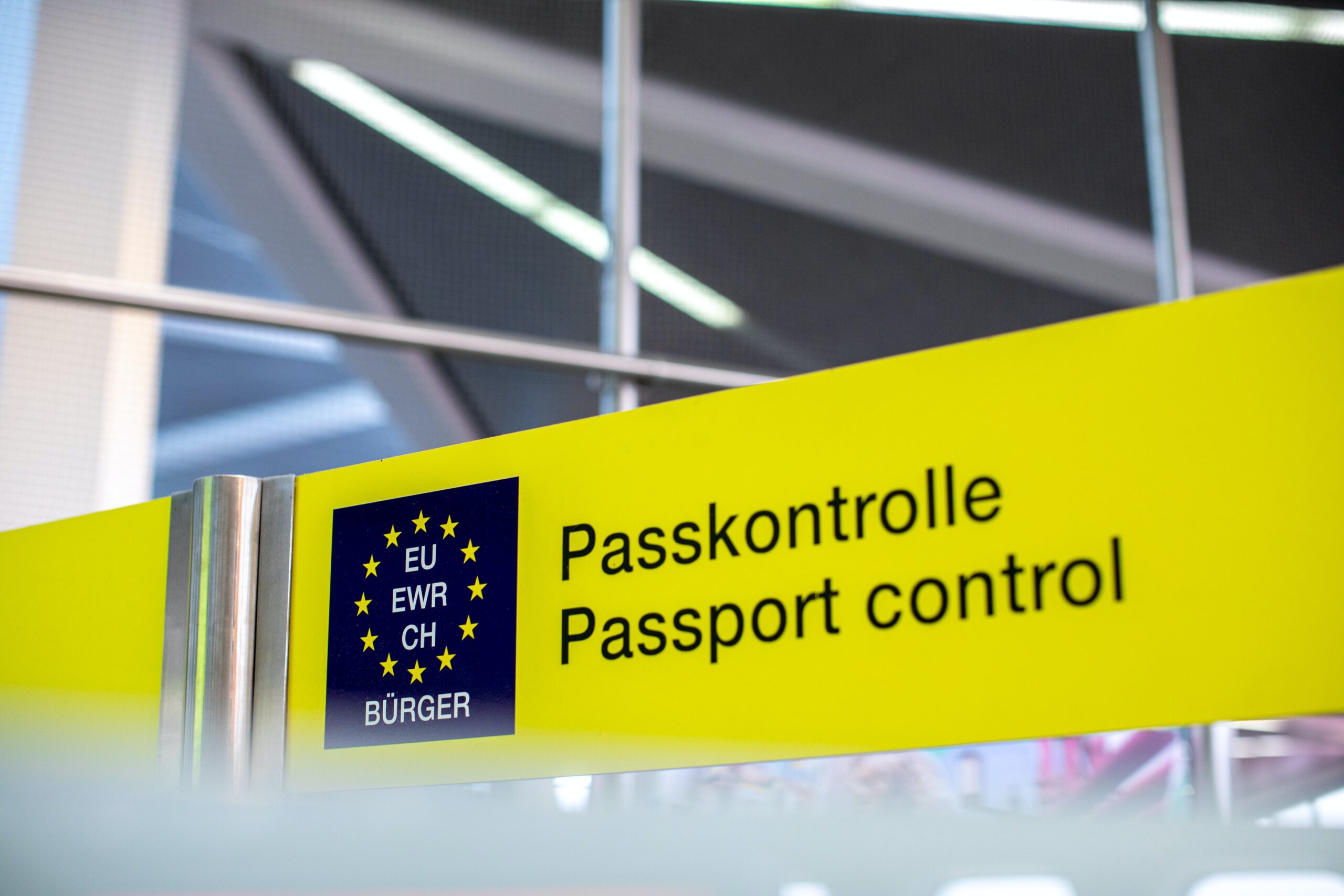
Dr Dug Cubie
Dr Dug Cubie of the School of Law, University College Cork is Programme Director, LLM in International Human Rights Law & Public Policy, and Co-Director of the Centre for Criminal Justice & Human Rights (CCJHR).
“We are witnessing a changed reality in that forced displacement nowadays is not only vastly more widespread but is simply no longer a short-term and temporary phenomenon.”
Filippo Grandi, UN High Commissioner for Refugees (June 2020)[1]
Introduction
The 1951 UN Refugee Convention has provided the foundations of the global regime to protect persons fleeing persecution and human rights abuse for over 70 years,[2] and millions of people have benefitted from the right not to be returned to a place where they would face serious risk (the concept of non-refoulement).[3]
However, it has long been recognised that the Refugee Convention only addresses one form of forced displacement – people who have fled across an internationally recognised border, and who have faced individualised persecution based on one of five key characteristics, namely: race, religion, nationality, membership of a particular social group, or political opinion.[4]
So what happens if someone is displaced within the borders of their own country? What are the responsibilities of a State regarding such internal displacement? Likewise, how do we address more generalised risks, such as systemic violence, sea level rise, or loss of agricultural land due to drought, which can equally lead to displacement of people? The climate emergency creates an urgency in understanding the drivers of mobility, both within countries and across international borders. This is particularly pertinent since, as the UN High Commissioner for Refugees, Filippo Grandi notes, not only are we seeing a broader range of types of forced displacement, but this displacement is becoming more long-term and cyclical, which raises important questions from both a protection and legal perspective.[5]
While the extent of, and situations which can lead to, forced displacement are increasingly being recognised, these insights are not new. Nearly 30 years ago, the leading human geographer Graeme Hugo set out his understanding of the “continuum” of displacement. Hugo’s model highlighted that it can be hard to identify precise drivers of displacement, since there can be many factors influencing an individual’s decision to move from one place to another. At one end of the continuum is voluntary migration, in which the will and choice of the migrant is the decisive factor, while at the other end is forced migration where people are faced with serious harm or death if they remain where they currently live.[6] Between these two extremes are a wide range of situations in which individuals have varying levels of agency in deciding whether or not to move from their current place of residence. Hugo distinguishes between voluntary, involuntary, and forced migration, and this continuum forms the basis for the following analysis in this paper.
The first section of this paper provides an overview of the phenomenon of forced displacement in a global context by outlining some of the trends in forced displacement as reported by organisations such as the UN High Commissioner for Refugees (UNHCR), the International Organization for Migration (IOM), and the Internal Displacement Monitoring Centre (IDMC). The paper will then examine different scenarios which can lead to forced displacements, namely: armed conflict, human rights abuse, climate change, and disasters. Each of these scenarios will be analysed through the lens of a specific country/regional context; however, it should be noted that the complexity of such displacement settings can be hard to capture in only a few pages. The final section will provide some reflections on future challenges and potential areas for hope.
Overview of Forced Displacement
The 1990s were a key stage in our understanding of the different forms of forced displacement – from Graeme Hugo’s analysis of environmental migration,[7] to the development of the UN Guiding Principles on Internal Displacement.[8] Consequently, there was an increased focus on reporting, monitoring and quantifying the extent of non-refugee forced displacement at a global level, as evidenced by the establishment of the Internal Displacement Monitoring Centre (IDMC) within the Norwegian Refugee Council in 1998[9] and the commencement of IOM’s Migration Research Series in 2000.[10] This in turn led to the identification of more accurate and detailed statistics on the extent of global forced displacement. As the UN High Commissioner for Refugees (UNHCR) has recorded, between 1990 and 2010 there was a fairly consistent level of global forced displacement of between 30-50 million people per annum.[11] However, the past 10 years have seen a significant increase in all forms of forced displacement, defined by UNHCR as displacement resulting from “persecution, conflict, violence, human rights violations or events seriously disturbing public order.”[12]
This persistent and global increase in forced displacement is as a result of a range of complex events at the local, regional and global levels. Some of the drivers of displacement are interconnected, for example climate change can exacerbate socio-economic conditions which may in turn lead to armed conflict[13] – which provides a worrying glimpse into potential future trends of displacement. Meanwhile, the ongoing crises in countries such as Syria, Afghanistan and Venezuela have led to millions of people being displaced from their homes due to violence and hunger. As per UNHCR’s statistics, by the end of June 2021 there were a total of 85.8 million people forcibly displaced around the world. This figure is comprised of 26.6 million refugees, 4.4 million asylum seekers, 3.9 million displaced Venezuelans, and 50.9 million internally displaced persons.[14] Indeed, despite wide-spread movement and travel restrictions across the globe arising from the COVID-19 pandemic, UNHCR reported that the total number of internally displaced persons rose by nearly 5% between December 2020 and June 2021.[15]
Internally displaced persons are, by definition, still within the borders of their country of nationality or residence, so the primary responsibility for their protection and support rests with that State.[16] Conversely, persons who cross a border in search of protection and safety must rely on either the support of the host State or the international community. Yet in reality this responsibility is not shared equally across all countries in the world, and the majority of people who are forcibly displaced across a border are hosted in a neighbouring country. Consequently, a small number of countries carry a disproportionate burden in hosting people fleeing violence, conflict, and persecution. In mid-2021, five countries were supporting a third of all refugees, asylum seekers and displaced Venezuelans, with Turkey hosting 3.7 million and Colombia, Uganda, Pakistan and Germany each hosting around 1.5 million people.[17] A small number of countries also account for a disproportionate number of the world’s displaced persons, with more than two thirds of all internationally displaced persons originating from just five countries (Syria, Venezuela, Afghanistan, South Sudan and Myanmar).[18]
Considering the dynamic and challenging contexts in which forced displacement occurs, there can be differences in the methodologies and results of attempts to quantify the total number of people who are displaced at any one time.[19] Alongside, the UNHCR Global Trends reports, the IDMC annual Global Report on Internal Displacement (called the GRID Report) provides another key source of information and statistics on the trends and drivers of internal displacement.[20] The GRID Report 2021, covering the year 2020, noted that a total of 40.5 million people were newly displaced within the borders of their State or territory over the course of 2020 (see Figure 1).[21] Of these, 9.8 million were displaced by conflict and violence and 30.7 million were displaced by disasters. This reflects the huge impact that disasters such as flooding, storms and earthquakes can have on population movement.
These statistics also show that at the end of December 2020 there was a total of 55 million people internally displaced around the world, the highest level ever recorded. In other words, a considerable number of people were facing persistent and long-term displacement, in addition to large numbers of newly displaced persons. Of note, while the vast majority of new displacements which occurred during 2020 were as a result of disasters, the converse is true for long-term displacement. Of the 55 million people who remained displaced at the end of 2020, 48 million had been displaced by conflict and violence, and 7 million as a result of disasters (see Figure 2).[22] What these statistics tell us is that large numbers of people are displaced by disasters, but generally this occurs for a shorter period of time than those who are displaced by conflict and violence. This is understandable, as people may be able to return to their homes once flood waters have receded, but may not be able to return if an armed conflict is on-going or if their home has been destroyed by fighting.
However, in a ground-breaking decision in September 2020, the UN Human Rights Committee examined the case of the Teitoita family, Kiribati nationals who had claimed asylum in New Zealand based on the risk of rising sea levels due to climate change.[23] While finding that the risk to life was not sufficiently imminent in this particular case, the Human Rights Committee accepted Mr Teitoita’s argument that “sea level rise is likely to render Kiribati uninhabitable” and that the effects of climate change “may expose individuals to a violation of their rights … thereby triggering the non-refoulement obligations.”[24] If areas, or even entire countries, become uninhabitable due to the effects of climate change in the foreseeable future, this will require a monumental re-evaluation of how we view and respond to forced displacement.
Different forms of forced displacement
Following this brief overview of global forced displacement, this section will provide a series of case studies to examine the issues raised by different drivers of displacement, namely: armed conflict, human rights abuses, climate change and disasters.
Armed conflict – Syria
Throughout history, war and conflict have been one of the leading drivers of forced displacement and refugees. Unfortunately, little has changed in the 21st Century. Just as the conflicts in Vietnam and the former Yugoslavia defined their eras, the decade-long conflict in Syria has created unimaginable suffering and destruction, which has had wide reaching impacts in the Middle East, Europe and beyond. Since the Syrian Government’s violent response to demonstrations in the southern city of Deraa in March 2011, it is estimated that over 500,000 people have been killed, or are missing and presumed dead, as a result of the conflict.[25] Over 12 million Syrians have fled their homes – more than half the population of the entire country – with 5.6 million Syrians having crossed into neighbouring countries or secured protection further afield, and 6.6 million people who remain internally displaced within Syria.[26] Writing as a displaced person, Ammar Azzouz recounted his horror at watching the destruction of his home city of Homs from afar.[27] Not only have historic monuments been destroyed, such as in Palmera or the Old City of Aleppo, but the streets, schools and bakeries which people used to safely inhabit have disappeared.[28] As Azzouz notes “Cities have turned into battlefields.”[29]
Such violence represents the extreme end of Graeme Hugo’s continuum, as people have faced life or death decisions about moving at short notice as a result of the conflict. The length of time which the Syrian conflict has been ongoing can be hard to comprehend, as is the impact on families, livelihoods, health and resultant psychological trauma. As highlighted by research undertaken by the International Committee of the Red Cross (ICRC), nearly half of all young people that they surveyed have had a close relative or friend killed in the conflict, and one in six youth reported that at least one of their parents had been killed or seriously injured.[30] Likewise, Médecins sans Frontières (MSF) has reported on the extensive destruction of public buildings such as schools and hospitals, as well as essential infrastructure including water and sanitation systems.[31] Indeed, the length of the conflict has resulted in intergenerational displacement and trauma, with UNICEF reporting in 2018 that over 4 million Syrian children had been born since the conflict commenced.[32] As of 2022, the number of children born into the conflict or displacement will be much higher. Consequently, an entire generation is growing up under the shadow of violence and uncertainty. Unfortunately, the duration and on-going nature of the displacement within Syria and the surrounding region causes extensive challenges in finding any form of resolution for all those displaced.
Drawing on UNHCR’s assessment of durable solutions for refugees and displaced persons, there are three potential options: i) voluntary return in safety and dignity; ii) local integration in the host community of displacement; and iii) resettlement to a third locality or country.[33] Yet in situations of armed conflict, it can be impossible to identify safe and sustainable durable solutions in areas where the violence is ongoing. Moreover, the option of resettlement to a third country is limited to a very small percentage of all those displaced and so is out of reach for the vast majority.[34] Tragic deaths such as the drowning of three-year old Alan Kurdi in September 2015 may have prompted soul searching among many of us living in safer parts of the world,[35] but countless other children and adults have been killed in the years since[36] and without a realistic political agreement between all warring parties, the prospect of return for many Syrians remains a dream for the future.
Human rights abuses – Myanmar/Rohingya
While the final results may be the same, i.e. forced displacement, there are important differences between a recognised conflict between two or more armed groups, and a campaign of human rights abuse and persecution against a particular group within a society. Such targeted attacks by governmental forces (whether originating from the military, semi-State para-military groups, or police forces) against civilians is exactly the type of scenario envisaged by the drafters of the 1951 Refugee Convention in the aftermath of the Holocaust. Consequently, in international law, widespread and systematic attacks against a civilian population are classified as a crime against humanity, or even genocide.[37] Such attacks often first lead to internal displacement, which is then followed by cross-border displacement as the people targeted by such attacks seek safety.
Prior to the most recent campaign of persecution and human rights abuse which commenced in 2016, the Muslim Rohingya population in Myanmar was comprised of approximately 1 million people, out of the total population of 52 million people. However, due to non-recognition by the Myanmar Government, for example when conducting the 2014 official census, the Rohingya were not deemed to be Myanmar citizens.[38] The Rohingya, based primarily in Rakine State, have faced recurring periods of persecution since the 1960s. However, a particularly vicious and concerted campaign commenced in August 2017 which resulted in nearly 750,000 people fleeing across the border into southern Bangladesh over a three-month period.[39] This was the largest single refugee displacement in Asia since the 1970s. The resultant refugee camps in Cox’s Bazaar, which merged with an existing refugee population of over 200,000 Rohingya who had fled Myanmar in previous years, have swelled to host over 1 million people, and the central camp of Kutupalong is the most densely populated refugee camp in the world.[40]
Irrespective of any potential for durable solutions, the living conditions in camps such as this are extremely difficult to control, despite the best efforts of local and international humanitarian actors. For example, in March 2021, a major fire swept through large parts of the camp complex destroying over 10,000 shelters and killing at least 15 people, with over 400 others reported as missing.[41] The risks and challenges of living as a displaced person compound the physical and psychological impacts of the original physical, mental or sexual violence that precipitated flight.[42] There are some welcome signs that the refugee communities themselves are increasingly involved in the decision-making process surrounding their daily living. For example, in late 2020, a team of Rohingya field researchers, supported by IOM staff, undertook research on accountability and inclusiveness in the response by humanitarian organisations and sought to understand the Rohingya community’s thoughts, experiences, and preferences. While expressing their gratitude for the support of the local, national and international actors, the refugees highlighted their lack of involvement in decision-making and need for clear feedback and complaints mechanisms.[43]
Despite such positive moves, the instability of the refugees’ situation was forcibly highlighted in early 2021 following the military junta’s coup against the democratically-elected Government of Myanmar. Human Rights Watch and others called on international governments, in particular Bangladesh and India, to respect the principle of non-refoulement and halt all forced returns to Myanmar.[44] Indeed, Syeda Rozana Rashid has argued that the traditional three durable solutions are “almost unachievable” for the Rohingya, and notes that the Rohingya have been caught between the politics of expulsion and repatriation for decades.[45] In a similar manner to the entrenched positions in the Syrian conflict, Rashid argues that unless the Myanmar Government changes its policy of exclusion of the Rohingyas, there cannot be sustainable durable solutions. The three key actions, as identified by Rashid, are equally applicable in many forced displacement contexts:
- Addressing the root causes of Rohingya’s forced migration from Myanmar and ensuring voluntary return of the Rohingya;
- Sharing of the burden by the international community and prosperous states; and
- Making the voices of the refugees heard.[46]
Alongside the work being undertaken in the refugee camps, there are some interesting legal developments taking place which, while not providing any immediate solution to the crisis, may create forums for holding the Myanmar Government to account for the expulsion of the Rohingyas. First of all, in November 2019, The Gambia commenced a case against Myanmar in the International Court of Justice (IJC) on the basis that genocide was being committed against the Rohingya.[47] Most notably, in January 2020 the Court ruled on a series of preliminary measures, including placing a legally binding obligation on the Myanmar to:
- take all measures within its power to prevent the commission of all acts within the scope of the Genocide Convention;
- ensure that its military, as well as any irregular armed units which may be directed or supported by it and any organisations and persons which may be subject to its control, direction or influence, do not commit any such acts;
- take effective measures to prevent the destruction and ensure the preservation of evidence related to allegations of such acts; and
- to submit a report to the Court on all measures taken within four months, and thereafter every six months, until a final decision on the case is rendered by the Court.[48]
As of the time of writing, the case is still ongoing before the ICJ, partly due to a series of delays caused by the COVID-19 pandemic as well as the military coup of March 2021 and subsequent arrest of Ang San Suu Kyi.[49]
Separately, in November 2019, the Pre-Trial Chamber of the International Criminal Court authorised the Office of the Prosecutor to initiate a preliminary investigation into the potential commission of crimes against humanity and genocide in regard to the forced displacement of the Rohingyas.[50] However, the investigation is limited as a result of Myanmar’s refusal to sign the Rome Statute of the ICC. While the investigation’s primary focus on the deportation of Rohingya from Bangladesh (which is a signatory to the Rome Statute) is constrained, the ongoing work of the Prosecutor of the International Criminal Court highlights the seriousness which the systematic attacks against the Rohingya are being taken and provides an additional means of accountability and advocacy for those displaced.
Climate change and disasters – The Horn of Africa & Mozambique
The final two scenarios which can lead to forced displacement are closely connected, so will be examined together. Although it should be remembered, as noted in Section 2 above, key differences exist between the drivers and, more importantly, potential duration of displacement caused by disasters and climate change. Graeme Hugo’s original iteration of the continuum of migration focused heavily on environmental drivers of displacement, including pollution and land degradation.[51] While these are still important causes of displacement, in the past 30 years the serious threat posed by global climate change has slowly been recognised. Likewise, our understanding that there is no such thing as a “natural” disaster,[52] has forced us to reconsider the role of prevention, preparedness, and risk reduction from both a humanitarian response and migration management perspective. As global temperatures rise, this can lead to more frequent, severe, and unpredictable hydrometeorological hazards, such as tropical storms, king tides, and flooding. Therefore, we need to prepare for more people being affected by such disasters on a more regular basis.[53] However, in addition to sudden-onset events such as cyclones, climate change will also lead to slow-onset risks, such as salination of previously arable land as a result of sea surges, or conversely drought arising from a change in rainfall patterns. This final section will therefore briefly examine the impacts on Mozambique of a series of tropical cyclones in recent years, as well as the regional impact of drought in the Horn of Africa.
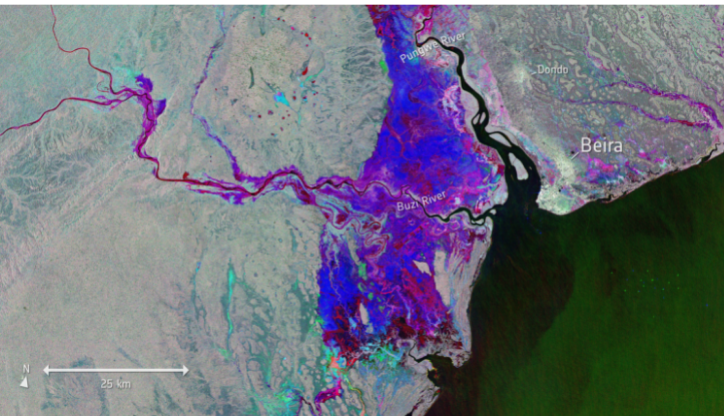
Scale of flooding in Mozambique after Cyclone Idai in March 2019. European Space Agency (CC BY-SA 2.0)
Over a six-week period in March and April 2019, two severe tropical cyclones hit Mozambique, resulting in at least 603 people killed, over 1,600 people injured, and over 500,000 people being displaced within the country.[54] The unprecedented nature of two such cyclones hitting in quick succession exacerbated the humanitarian challenges, with UNICEF reporting that 2.5 million people were in need of humanitarian assistance, including 1.3 million children.[55] Cyclone Idai made landfall on 15th March in the port city of Beira in Sofala province in the centre of Mozambique, while on 25th April Cyclone Kenneth hit the northern province Cabo Delgado which was already suffering from the impact of armed conflict. Even before Cyclone Kenneth made landfall, IOM had reported that nearly 130,000 people were sheltering in evacuation centres.[56] Since then, Mozambique has suffered a series of further powerful cyclones, including Tropical Storm Chalane in December 2020, Cyclone Eloise in January 2021 and Cyclone Gaumbe in February 2021. While causation linking individual natural hazards to climate change can be hard to determine, the World Meteorological Organisation is closely monitoring the increasing frequency of such tropical storms, and has highlighted the need for early warning and preparedness systems.[57] As one IOM staff member reported following Cyclone Eloise, people in the evacuation centres kept asking IOM staff, “Why us? What have we done to deserve this?”[58] This is a question which has been posed in many countries suffering the worst effects of climate change, and it is recognised that the most vulnerable in society are likely to be hit hardest by the increasingly negative impacts of climate change.[59] It is perhaps not surprising that the potential relocation of at-risk communities has been debated. However, as Alex Arnall noted following a 6-month research period in central Mozambique, any such climate resettlement programmes need to be used as a last resort and in a voluntary manner.[60] The issue of in-situ climate change adaptation for individuals and communities who are unable or unwilling to move in the face of disasters and climate change must also be considered.[61]
The need for locally targeted solutions is particularly evident when one considers the specific needs of pastoralist communities in Africa. Back in 2008, Mohamed Adow was already highlighting the impacts of climate change on pastoralists in Kenya, and the challenges to their traditional ways of life arising from floods and droughts, and difficulties in finding grazing lands for their livestock.[62] The intersectionality of long-term pre-existing systemic vulnerabilities, exacerbated by the negative impacts of climate change, can be seen clearly in the Horn of Africa,[63] in particular as a result of recent droughts. Of note, the GRID Report 2021 reported that 5 million people were displaced by disasters and conflict across the eight countries found in the Horn of Africa during 2020.[64]
Multiple factors may influence people’s choices and agency when making decisions whether to remain in their homes or flee to somewhere safer, including the risk of conflict, poverty, poor governance and climate change.[65] As Alex Randall has argued: “Rather than seeing drought as the cause of armed conflict, it is more accurate to see armed conflict as a force that prevents governments coping with drought. And crucially preventing those droughts causing famine.”[66] Climate change acts as a risk multiplier in such situations, resulting in greater food insecurity, health outcomes and loss of livelihoods, and the potential for cyclical and secondary displacements. However, another aspect of displacement within the Horn of Africa is that most climate displacement is over relatively short distances – so the impacts are primarily felt in the locality and region.[67] There have also been some positive examples of regional cooperation, such as the agreement adopted by the Horn of Africa Intergovernmental Authority on Development (IAGD) in 2020 which endorsed the principle of free movement between the member states, thereby allowing communities to pre-emptively move to avoid potential disaster and climate impacts.[68]
Conclusions
This brief overview of forced displacement from a global perspective can only skim the surface of the challenges faced by, as well as the resilience of, many communities across the world. However, it is hard to avoid the conclusion that drivers of displacement, such as conflict, human rights abuse, climate change and disasters, are going to lead to greater levels of involuntary and forced displacement in the coming years. As a result, we are likely to see even greater levels of cyclical and secondary displacement, and there is unlikely to be any change to the stark fact that the global south will continue to host the largest number of displaced people, despite the fact that all countries are increasingly going to be affected by climate change and disasters. Likewise, without political will at the national and international levels, protracted displacements and conflicts, such as in Syria and Myanmar, will continue to cause new displacement and lack of options for durable solutions.
Nevertheless, there is cause for hope. The global youth movement which has arisen to tackle the inertia of Governments and industries has provided inspiration to many and is challenging vested interests in the name of climate justice, for example through the recent complaint made by climate youth activists to the UN Committee on the Rights of the Child.[69] Likewise, grassroots groups such as the Pacific Island Warriors who face the loss of their homes due to sea level rise have rallied behind the call “We are not drowning, we are fighting.”[70] So despite the seemingly overwhelming challenges to prevent and respond to both the climate emergency and forced displacement, concerted action by individuals, communities and States is possible to reverse the trend of ever-increasing forced displacement across the globe.
You can download a pdf of this document here
Footnotes:
[1] ‘Global forced displacement vastly more widespread in 2019’ UNHCR News (Adrian Edwards) 18 June 2020 <www.unhcr.org/en-ie/news/latest/2020/6/5eea140f4/global-forced-displacement-vastly-widespread-2019.html>
[2] UN, Convention Relating to the Status of Refugees (adopted 28 July 1951, entered into force 22 April 1954), 189 UNTS 137. The 1967 Protocol removed the geographic and temporal limitations set out in the 1951 Convention: UN, Protocol Relating to the Status of Refugees (adopted 31 January 1967, entered into force 4 October 1967), 606 UNTS 267.
[3] Elihu Lauterpacht & Daniel Bethlehem, ‘The Scope and Content of the Principle of Non-refoulement: Opinion for UNHCR’ (2001).
[4] Art 1(2)(A), Refugee Convention (n.3).
[5] The UN Inter-Agency Standing Committee (IASC), defines ‘protection’ as: “all activities aimed at obtaining full respect for the rights of the individual in accordance with the letter and the spirit of the relevant bodies of law (i.e. human rights law, international humanitarian law and refugee law).” See: IASC, Protection and Accountability to Affected Populations in the Humanitarian Programme Cycle: Preliminary Guidance Note, Emergency Directors Group (2015) pp.8-11.
[6] Graeme Hugo, ‘Environmental Concerns and International Migration’ (Spring 1996) 30(1) International Migration Review 105, 107.
[7] Ibid. See also: Douglas K. Bardsley and Graeme J. Hugo, ‘Migration and Climate Change: Examining Thresholds of Change to Guide Effective Adaptation Decision-Making’ (2010) 32 Population and Environment 238-262.
[8] UN Office of the Coordination of Humanitarian Affairs (UNOCHA), Guiding Principles on Internal Displacement (1998, revised 2004).
[9] See for example: Allehone Mulugeta Abebe, ‘Special Rapporteurs as Law Makers: The Developments and Evolution of the Normative Framework for Protecting and Assisting Internally Displaced Persons’ (2011) 15(2) The International Journal of Human Rights 286-298. For information on the work of the Internal Displacement Monitoring Centre (IDMC), see: <www.internal-displacement.org/about-us>.
[10] The IOM Migration Research Series has to-date published 77 detailed reports on a wide range of migration issues, and is available online at: <www.iom.int/migration-research-series>.
[11] UN High Commissioner for Refugees, Global Trends: Forced Displacement in 2020 (June 2021), p.2.
[12] Ibid.
[13] International Committee of the Red Cross (ICRC), When Rain Turns to Dust: Understanding and Responding to the Combined Impact of Armed Conflicts and the Climate and Environment Crisis on People’s Lives (July 2020).
[14] UN High Commissioner for Refugees (UNHCR), Mid-Year Trends 2021 (2021), pp.1 & 9.
[15] Ibid, p.9 (from 48.6 million to 50.9 million internally displaced persons).
[16] For a detailed regional law setting out the rights and responsibilities of States and individuals who have been displaced, see: African Union, Convention for the Protection and Assistance of Internally Displaced Persons in Africa (adopted 22 October 2009, entered into force 6 December 2012) (the ‘Kampala Convention’). For analysis, see: Allehone Mulugeta Abebe, ‘The African Union Convention on Internally Displaced Persons: Its Codification Background, Scope, and Enforcement Challenges’ (2010) 29(3) Refugee Survey Quarterly 28.
[17] UNHCR, Mid-Year Trends (n.15), p.1.
[18] Ibid.
[19] See for example: Dominic Kniveton et el, Climate Change and Migration: Improving Methodologies to Estimate Flows (2008) IOM Migration Research Series No.33.
[20] IOM’s annual World Migration Report is another source of authoritative statistics and analysis. The World Migration Report 2022 concluded that there was a total of 89.4 million forcibly displaced persons in the world at the end of 2020. IOM, World Migration Report 2022 (2021), p.4.
[21] Internal Displacement Monitoring Centre (IDMC), Global Report on International Displacement 2021: Internal Displacement in a Changing Climate (2021), p.3. This was the highest figure of new displacements in the past decade.
[22] Ibid, pp.7-8.
[23] UN Human Rights Council, Views adopted by the Committee under Article 5(4) of the Optional Protocol, concerning communication No.2728/2016 (23 September 2020) UN Doc: CCPR/C/127/D/2728/2016.
[24] Ibid, paras.9.11-9.12.
[25] BBC News, ‘Why has the Syrian War Lasted 10 Years?’ (12 March 2021) <www.bbc.com/news/world-middle-east-35806229>.
[26] World Vision International, Too High a Price to Pay: The Cost of Conflict for Syria’s Children (2021), p.9.
[27] Ammar Azzouz, “‘Every Day is War’ – A Decade of Slow Suffering and Destruction in Syria” (15 March 2021) The Conversation <https://theconversation.com/every-day-is-war-a-decade-of-slow-suffering-and-destruction-in-syria-154595>.
[28] Ibid.
[29] Ibid.
[30] International Committee of the Red Cross (ICRC), ‘Millions of young Syrians paid heavy toll during “decade of loss”’ (10 March 2021) <www.icrc.org/en/document/icrc-millions-young-syrians-paid-heavy-toll-during-decade-savage-loss>.
[31] Médecins sans Frontières (MSF), ‘Driven out by war, displaced in desperate conditions’ (nd) <www.msf.org/syria-depth>.
[32] UN News, ‘Four million Syrian children have only known war since birth: UNICEF’ (13 December 2018) <https://news.un.org/en/story/2018/12/1028461>.
[33] UNHCR, Framework for Durable Solutions for Refugees and Persons of Concern (Geneva, May 2003). See also, Inter-Agency Standing Committee (IASC), Framework on Durable Solutions for Internally Displaced Persons (Brookings Bern Project on Internal Displacement, April 2010), p.5.
[34] For example, between 2016 and April 2021, only 28,340 Syrian refugees were resettled across the whole of the EU. See: European Council for Refugees & Exiles (ECRE), Turkey Country Report: Resettlement and family reunification departures (last updated: 11 January 2022) <https://asylumineurope.org/reports/country/turkey/>.
[35] Mukul Devichand, ‘Did Alan Kurdi’s death change anything?’ (2 September 2016) BBC Trending <www.bbc.com/news/blogs-trending-37257869>.
[36] [See “Forced Displacement: Well-Founded Fear of Home” on Page 44 of this issue.)
[37] Arts. 6 & 7, Rome Statute of the International Criminal Court (adopted 17 July 1998, entered into force 1 July 2002) ISBN No. 92-9227-227-6. See generally: Samantha Power, “A Problem from Hell”: America and the Age of Genocide (William Collins, 2003)
[38] World Vision International, Rohingya refugee crisis: Facts, FAQs, and how to help (Kathryn Reid, last updated: 25 March 2021) <www.worldvision.org/refugees-news-stories/rohingya-refugees-bangladesh-facts#:~:text=The%20Rohingya%20people%20are%20a,which%20borders%20Bangladesh%20and%20India>.
[39] UNHCR, Rohingya emergency (nd) <www.unhcr.org/en-ie/rohingya-emergency.html>
[40] World Vision International (n.39).
[41] Alasdair Pal, Ruma Paul and Emma Farge, ‘“Devastating” fire at Rohingya camp in Bangladesh kills 15, leaves 400 missing – UN’ (23 March 2021) Reuters <www.reuters.com/world/asia-pacific/bangladesh-probes-fire-rohingya-refugee-camp-that-killed-seven-2021-03-23/>
[42] See, for example, analysis of the sexual and gender-based violence in the Bhutanese refugee camps in Nepal in 2003: Human Rights Watch, Trapped by Inequality: Bhutanese Refugee Women in Nepal (September 2003). See also: Birendra Giri, ‘Mourning the 15th Anniversary of Crisis: The Plight of Bhutanese Refugee Women and Children’ (2005) 40(5) Journal of Asian and African Studies 346-369.
[43] ACAPS-NPM Analysis Hub & IOM, Añárar Báfana – Our Thoughts: Rohingya share their experiences and recommendations (April 2021), pp.15-28.
[44] Human Rights Watch, India: Halt All Forced Returns to Myanmar – Returned Refugees Face Risks to Life, Liberty Under Oppressive Junta (10 March 2021) <www.hrw.org/news/2021/03/10/india-halt-all-forced-returns-myanmar>
[45] Syeda Rozana Rashid, ‘Finding a Durable Solution to Bangladesh’s Rohingya Refugee Problem: Policies, Prospects and Politics’ (2020) 5(2) Asian Journal of Comparative Politics 174-189, pp.174, 180.
[46] Ibid, p.186.
[47] As a so-called jus cogens norm, any state in the world can commence proceedings against another state under the 1948 UN Convention on the Prevention and Punishment of the Crime of Genocide (adopted 9 December 1948, entry into force 12 January 1951), Art. VIII.
[48] Application of the Convention on the Prevention and Punishment of the Crime of Genocide (The Gambia v. Myanmar) – Request for the Indication of Provisional Measures, Order of 23 January 2020.
[49] Details of the case proceedings can be found at: <www.icj-cij.org/en/case/178>.
[50] Situation in the People’s Republic of Bangladesh/Republic of the Union of Myanmar (ICC-01/19). Details of the investigation proceedings can be found at: <www.icc-cpi.int/bangladesh-myanmar>.
[51] For analysis and a variety of case studies, see: Dimitra Manou et al, Climate Change, Migration and Human Rights: Law and Policy Perspectives (Routledge, 2017).
[52] For more on this issue, see: <www.nonaturaldisasters.com/>. Likewise, the Climate and Migration Coalition has an excellent set of multimedia resources: <https://climatemigration.org.uk/>.
[53] For more information on some of the ongoing work examining the issue of disasters and displacement, see: The inter-governmental Platform for Disaster Displacement <https://disasterdisplacement.org/> and the IFRC, Disaster Law programme <https://disasterlaw.ifrc.org/>.
[54] Meteorological data for the cyclones can be found at: <https://blogs.nasa.gov/hurricanes/tag/idai-2019/> and <https://blogs.nasa.gov/hurricanes/2019/04/26/kenneth-southern-indian-ocean-5/>. Neighbouring countries were also affected, but not as severely as Mozambique.
[55] UNICEF, Cyclone Idai and Kenneth (nd) <www.unicef.org/mozambique/en/cyclone-idai-and-kenneth>.
[56] IOM, Mozambique: Cyclone Idai – Displacement Population and Flood Analysis (25 March 2019).
[57] World Meteorological Organisation, Tropical Cyclone Eloise hits Mozambique (22 January 2021) <https://public.wmo.int/en/media/news/tropical-cyclone-eloise-hits-mozambique>.
[58] Ibid.
[59] See, for example: Tommaso Natoli, Addressing Specific Vulnerabilities Through Climate and Disaster Risk Governance: Lessons from the Philippines, IFRC / UCC (Geneva, 2020).
[60] Alex Arnall, ‘Resettlement as Climate Change Adaptation: What Can Be Learned from State-led Relocation in Rural Africa and Asia?’ (2019) 11(3) Climate and Development 253-263, pp.258-259.
[61] Dug Cubie, ‘In-situ Adaptation: Non-Migration as a Coping Strategy for Vulnerable Persons’ in Manou et al (n.52), pp.99-114.
[62] Mohamed Adow, ‘Pastoralists in Kenya’ (October 2008) 31 Forced Migration Review 34.
[63] Encompassing: Djibouti, Eritrea, Ethiopia, Kenya, Somalia, South Sudan, Sudan and Uganda.
[64] GRID Report 2021 (n.22) pp.23-42.
[65] See for example: Vikram Kolmannskog and Tamer Afifi, Disaster-Related Displacement from the Horn of Africa (March 2014) Reports No.15, Norwegian Refugee Council.
[66] Alex Randall, Unpacking climate change and the Horn of Africa crisis (nd, Climate and Migration Coalition) <https://climatemigration.org.uk/climate-change-horn-africa-crisis/>.
[67] Fredu Nega Tegebu, Climate Change-Induced Migration in the Horn of Africa (May 2020) Policy Briefing, South African Institute of International Affairs, p.5. See also: Kolmannskog and Afifi (n.66).
[68] GRID Report 2021 (n.22) p.104.
[69] Aoife Daly, ‘Climate crisis: how states may be held responsible for impact on children’ (20 October 2021) The Conversation <https://theconversation.com/climate-crisis-how-states-may-be-held-responsible-for-impact-on-children-170130>.
[70] The Pacific Island Warriors, The Pacific Warrior Journey <https://world.350.org/pacificwarriors/the-pacific-warrior-journey/>.


